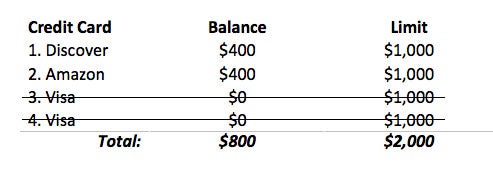We recently received a question from a reader who wants to know if there’s any way she can close unused credit cards without hurting her credit scores and how taking this action could impact her credit overall:
I have at least ten credit cards and I only use two of them — Amazon and a Discover card that I only use when I shop Costco. I really want to close the other accounts since I have so many, but I keep hearing how it can hurt your credit. I do not have a balance on any of the cards including the Amazon card. Is there anything else I can do?
While it may be tempting to close the unused cards, in most cases, it’s best to leave credit card accounts open. At the very least, it will help your revolving utilization — which is a significant factor in your credit scores. Closing a credit card, let alone seven cards at once, could inadvertently cause a spike in your utilization percentage and tank your scores.
Credit Card Utilization
To explain, revolving utilization is the percentage of your balances in proportion to your credit limits, and accounts for roughly 30% of your credit score. The FICO score, specifically, looks at both individual utilization and aggregate — or total utilization across all of your credit cards. If there is a large available balance on the card you plan to close, closing it would close off the available balance and could have a negative impact on your utilization percentage. This is where all of your other credit cards come into play and impact the outcome.
The best advice is to avoid closing older, unused credit cards —especially those with zero balances — because the open credit limit helps your overall revolving utilization. In cases where it makes sense to close a credit card — when a card has an annual fee that’s not worth the cost, for example — you’ll want to make sure you do the math before closing the card. As long as closing the account doesn’t have a significant impact on your revolving utilization percentage (causing it to spike), the impact on your credit score would be minimal. To be safe, however, it’s worth taking the time to run the numbers yourself to be sure.
Calculating Revolving Utilization: Doing the Math
To calculate your revolving utilization yourself, you’ll want to pull all of your most recent credit card statements on all of your open credit card accounts. If you don’t have access, or cannot remember all of them, your credit reports will list all of your actively reported cards and you can pull the most up-to-date information from there. This is also a good idea because some credit card issuers — especially smaller issuers or credit unions — may only report to one or two bureaus, rather than all three. This would mean the impact to your credit scores could vary across the three credit reporting agencies. Remember, you’re entitled to one free copy of your credit reports from all three bureaus once a year, so if you want to be thorough, use your annual freebie and run the calculation across all three. (It’s also not a bad idea to keep an eye on how your utilization is affecting your credit score, which you can do for free using Credit.com’s Credit Report Card.)
Once you’ve pulled your list of open credit card accounts together, you’ll make two columns and list out all of the credit limits for each card, and then all of your current balances on each. Add up all of your credit limits and do the same for your balances, divide your total balance by your total credit limits and multiply by 100 to get the percentage. Here’s how the formula works:
Total Balances ÷ Total Credit Limits = Total Utilization × 100 = %
To illustrate how this works, let’s say you have four credit cards, each credit card has a $1,000 credit limit, and two of the cards have $400 balances, the other two have $0 balances:
Example #1:
$800 ÷ $4,000 = .2 × 100 = 20% Revolving Utilization
With this example, the revolving utilization is 20%. Now, if we take the same example and close both of the cards with $0 balances, here’s what happens:
Example #2:
$800 ÷ $2,000 = .4 × 100 = 40% Revolving Utilization
In this example, if you were to close the two cards that weren’t being used and remove it from the calculation, the utilization would jump from 20% to 40% — which is pretty substantial — and your credit scores would take a hit. You see, a higher utilization will hurt your credit score. And ideally, if you want to score well in this category, you’ll want to keep your utilization percentage to 10% or less for the maximum credit score points.
Bottom Line
In the end, it’s best to leave an unused credit card account open because the open credit limit would help your total revolving utilization. The credit card issuer may decide to close the account due to inactivity at some point, but unless you know how closing the card will impact your scores, it’s safer to keep it open.
Image: iStockphoto
You Might Also Like
June 4, 2024
Credit Score
March 7, 2023
Credit Score
January 4, 2021
Credit Score








